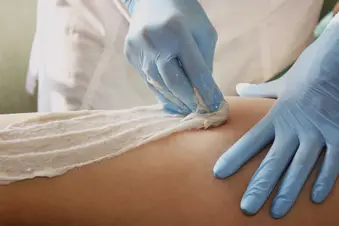
Red, scaly skin patches are the main symptom of psoriasis. There’s no cure for this skin condition, but treatment helps. And there are steps you can take to mask problem areas. That can make you feel better about how you look and get your day off to a good start.
Wash up. You want to start with a clean surface. So start your day by using a soft washcloth and a mild cleanser to gently rub away flaking skin. This will give your skin a smoother look. Flakes can make your skin appear bumpy and uneven, even when you’re wearing makeup.
Use scalp oil. Thick scales on your forehead, hairline, behind your ears or on the back of your neck can be softened with coconut, olive, or peanut oil. Massage a small amount into your scalp, then wrap your head in a towel and wait 30-60 minutes. Wash with your usual shampoo, then use a comb to gently loosen and remove the scales.
Buy medicated shampoo. Talk to your doctor about a good product for you. These shampoos can help loosen rough scales on your scalp, but they won’t always do a good job of cleaning your hair. After using one, follow with a regular shampoo. This will make sure you get rid of any odd “medicine” smell and make your hair easier to style.
Shave wet. Use a shaving cream or lotion made for sensitive skin and buy a good razor that follows the contours of your skin. Shaving wet instead of using an electric razor on dry skin is gentler on patches. Afterward, make sure to moisturize. You may find that skipping a day between shaves is easier on your skin.
Moisturize. Choose an ointment, oil, or thick cream. These types of moisturizers do a better job of getting through your skin barrier. Light lotions have more water and may dry out your skin even more. Your doctor can help you pick the right moisturizer for your problem areas. They may suggest products that contain a natural compound called urea. It helps soften the outer layer of your skin cells so they shed more easily. Lactic acid is another substance that can help ease scaly patches. Let the moisturizer sink into your skin. You should give it a good 10 minutes.
Put on a primer. These products help prepare your face for the makeup to follow. They don’t sink into your skin but stay on top of it, creating an extra layer. That gives you a smooth surface for your makeup. Don’t put on too much primer. You just want a light layer. Wait again. Let the primer set on your skin. It should only take a few minutes.
Use makeup to cover up. There are makeups made to hide skin issues like psoriasis. Talk to your doctor about a good product for you. You’ll want to consider thickness. You’ll need a thicker makeup for larger patches that are harder to hide. Look for a color that closely matches the skin tone of the skin surrounding your psoriasis. Gently blend a small amount of the makeup over the area you want to cover. Follow with a dusting of loose powder to make it last longer. You can even use hairspray to help make it set.
Be stylish. If you still are concerned about a problem area, use scarves, hats, or jewelry to draw attention away from your skin.
Enjoy yourself. By following these steps, you should be able to focus on the things you want to. Bring some makeup with you in case you feel the need to touch up. Remember: You’re likely thinking about your psoriasis more than anyone else does.
Smooth removal. When the day is done and it’s time to take off your makeup, make sure you go about it the right way. You don’t want to irritate your sensitive skin. You’ll need a gentle makeup remover. Something with a petroleum base works well. And make sure to moisturize when you’re done.
Show Sources
Photo Credit: iStockPhoto / Getty Images
SOURCES:
Mayo Clinic: “Psoriasis: Lifestyle and Home Remedies,” “Psoriasis: Treatment and Drugs.”
National Psoriasis Foundation: “Makeup tips for skin with psoriasis,” “The great coverup: Psoriasis makeup.”
The Psoriasis and Psoriatic Arthritis Alliance: “Skin Camouflage,” “Scalp Psoriasis.”
DermNet New Zealand/New Zealand Dermatologic Society: “Urea.”
American Osteopathic College of Dermatology: “Psoriasis.”
Dermascope Magazine/Aesthetics International Association: “Sugaring for Eczema and Psoriasis.”